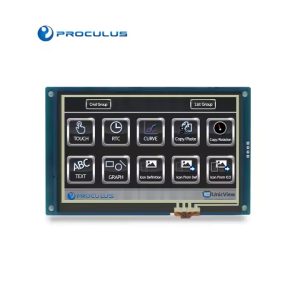Methods to Improve Contrast of LCD Module
Contrast is one of the main factors that affect the display effect of the liquid crystal module. The so-called contrast refers to the contrast between the bright area and the dark area in the display screen of the liquid crystal module. For monochrome displays, the higher the contrast, the clearer the display, while for color displays, the higher the contrast, the more vivid and vivid the image. There are two main contrast parameters for liquid crystal modules, one is the typical value, and the other is the maximum value. The maximum value is often an instantaneous value, which is not representative, and the typical value has reference value. At present, the contrast ratio of mainstream liquid crystal modules is generally at the level of 400:1 to 600:1, and the good ones can reach 1000:1 or even higher. The contrast of the liquid crystal module is too low, it is difficult to see the display content.
The contrast of the liquid crystal module directly affects the gray level and color level performance in the image. The increase in contrast will make the image have a stronger sense of hierarchy, and the bright and dark areas will be obvious, which means that the user can more easily see the image in the dark and gray conditions of the scene. How to improve the contrast of the LCD module? There are several ways.
1. Optimize the voltage of the LCD module
This program is the most economical. For liquid crystal modules, different viewing angles require different driving voltages. If the voltage is too low, the LCD module will be dim. When the voltage is too high, the LCD module will display a non-selected segment (ghosting). Therefore, when discussing the best contrast, we must first determine the voltage, and improve the contrast of the liquid crystal module by optimizing the voltage.
2. Improve the panel technology of LCD modules
The contrast of the liquid crystal module can be improved by improving the panel technology of the liquid crystal module, and the contrast of the display screen using a TN panel is relatively low. IPS and VA technologies can be adopted, that is, liquid crystal modules using IPS type panels and VA type panels. The contrast ratio of the liquid crystal modules of these two types of panels is much higher than that of TN. And generally, the current LCD module manufacturer adopts this technology.
3. Use better polarizers for LCD modules
The higher the polarization efficiency of the polarizer, the better the contrast of the liquid crystal module. The effect of the negative display is the most obvious. If the polarization degree of the polarizer is changed from 98% to 99%, the contrast of the negative LCD display can be increased from 45 to more than 1000, and the contrast of the positive LCD can be increased from 7 to 10 . For ambient light, the stronger the reflectivity of the polarizer, the better the contrast; when using a backlight, the higher the transmittance of the polarizer, the better the contrast.
4. Application of high-quality LCD module orientation layer
The initial alignment of the liquid crystal molecules in the liquid crystal module determines the contrast, response time, viewing angle and other properties of the display screen, and the alignment layer material can induce uniform alignment of the liquid crystal molecules. The new type of soluble polyimide uses high-quality rubbing fibers and high-quality rubbing equipment to make the liquid crystal molecules evenly arranged, thereby improving the contrast of the liquid crystal module.

 English
English


